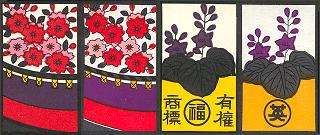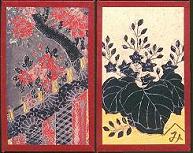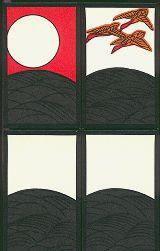Despite the charming name, meaning
"flower cards", and the
fascinating pictures in Japanese style, they are used for the most popular gambling card
game played in the country. A few people, though, enjoy the game for pleasure.
What is now generally called
Hanafuda is only one among the patterns that once
formed the numerous flower card group.
The present one is more properly referred to as
 Hachihachifuda
Hachihachifuda, i.e.
"eight-eight cards", after the name of the main game played with it, or
 Hachihachibana
Hachihachibana ("eight-eight flower cards").
This pattern was born during the Meiji period (1868-1912), following some slight yet
interesting graphic changes to the early design, which instead was basically retained by the
Echigobana
pattern, described in
page 3.

any difference between these two editions,
Nintendo (left) and Ace (right) is barely noticeable |
Unlike other regional patterns, the design of the
Hachihachi pattern has reached a steady standard, and editions made by different
manufacturers can be hardly told one from the other.
Besides the illustrations, also the size of the early 19th century decks was surely
larger, almost double the size of modern flower cards.
Since the Hachihachi is the only pattern still in use, it has been chosen for the general description
page. |
The Hanafuda pack is made of 48 cards, inspired by the twelve months of the year. In a similar way,
the subjects are divided into twelve families (suits), representing flowers or plants.
A further blank card belongs to the deck: it is either completely white in some editions, or
features a grotesque mask in others (see also page 3 and
page 4). This card can be used as a replacement in the case
one of the subjects goes lost, but when participants are more than three (the maximum number of
players allowed by most versions of the game), the blank or "joker" is actively used for
deciding who will play: whoever receives this card with the opening deal has to declare
it, and will skip the hand. |

the same two subjects as above, from
a 19th century edition (Ôishi, Japan) |
The table below shows relations between the names of the suits and the relevant months.
According to some sources, the ordering of the Paulownia and Willow suits
should be reversed (Paulownia = November and Willow = December), but the
matches indicated in table above are indeed the most common ones in Japan.
The arrangement of the Hanafuda deck is rather complicated. Each suit is made of
four cards, which may belong to four different categories:

kasu cards from
(top row) Pine, Cherry,
(top row) Peony and Maple |

the full Eulalia suit:
(above) hikari card (Moon), tane,
and (bottom) two kasu cards |
- Kasu cards: their Western equivalent is
"junk" or "trash cards", as they only score 1 point. Two almost
identical ones are found in each suit, featuring the stylized image of a plant
or a flower.
- Tan or Tanzaku cards: these ones feature
a vertical ribbon similar to the ones traditionally used for writing short poems (tanzaku), so their
Western name is usually "ribbon cards" (or "scroll cards"). There are three red ones with a
Japanese text in Pine, Plum and Cherry families, four red ones without any
text in Wisteria, Iris, Bush Clover and Willow families, and three purple ones without text
in Peony, Chrysanthemum and Maple.
All tan cards normally score 5 points. |